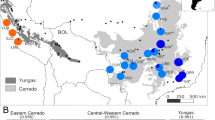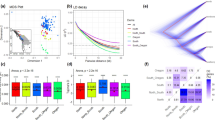Abstract
Temporal genetic variation was studied within the cyclic parthenogenetic Daphnia galeata-cucullata species complex in Lake Tjeukemeer (The Netherlands). During three successive years, three allozyme loci were studied in order to compare the level of genetic variation in D. galeata (G), D. cucullata (C) and their interspecific hybrid (C × G). This data set was used to investigate: whether C × G hybrids are regularly produced by the parental species and to what extent backcrossing takes place in this species complex. G and C × G were the most abundant taxa, whereas C was only abundant in late summer and autumn. Genetic diversity was highest in C, lowest in G, and intermediate in C × G. pgm and pgi allele frequencies of C × G were not intermediate to those of the parental species but were more similar to G than to C. In addition, almost no significant deviations from Hardy-Weinberg were observed. An UPGMA analysis of Nei's genetic distances showed that C × G hybrids are more closely related to G (difference <0.04), than to C (difference 0.30). My data suggest, in accordance with other studies, that C × G hybrids are probably still formed by the parental species, though not necessarily every year. Furthermore, my data suggest that backcrossing occurred frequently, and led to introgression of C alleles into G.
Similar content being viewed by others
Article PDF
References
Ayala, F J. 1983. Enzymes as taxonomic characters In: Oxford, G S. and Rollinson, D. (eds) Protein Polymorphism: Adaptive and Taxonomic Significance, pp. 3–26. Academic Press, London.
Barton, N H, and Hewitt, H H. 1985. Analysis of hybrid zones. Ann Rev Ecol Syst, 16, 113–148.
Barton, N H, and Hewitt, H H. 1989. Adaption, speciation and hybrid zones. Nature, 341, 497–503.
Boersma, M. 1995. Competition in natural populations of Daphnia. Oecologia, 103, 309–318.
Einsle, U. 1983. Die Entwicklung und Männchenbildung der Daphnia Population im Bodensee-Obersee 1956-1980. Schweiz Z Hydrol, 45, 321–332.
Flößner, D. 1993. Zur Kenntnis einiger Daphnia-Hybriden. Limnologica, 23, 71–79.
Flößner, D, and Kraus, K. 1986. On the taxonomy of the Daphnia hyalina-galeata complex (Crustacea: Cladocera). Hydrobiologia, 137, 97–115.
Gießler, S. 1987. Mikroevolution und Populationsgenetik im Daphnia galeata/hyalina/cucullata-Komplex (Crustacea: Cladocera) eine Freilandsanalyse. Ph.D. Thesis, University of Munich, Germany.
Hebert, P D N. 1985. Interspecific hybridization between cyclic parthenogens. Evolution, 39, 216–220.
Hebert, P D N. 1987. Genetics of Daphnia. In: Peters, R. H. and de Bernardi, R. (eds) Daphnia Memorie Istitute Italiano Di Idrobiologia, 45, 439–460.
Hebert, P D N, and Beaton, M J. 1989. Methodologies for Allozyme Analysis using Cellulose Acetate Electrophoresis. Helena Laboratories, Beaumont, TX.
Hebert, P D N, Beaton, M J, Schwartz, S S, and Stanton, D J. 1989a. Polyphyletic origins of asexuality in Daphnia pulex. I. Breeding-system variation and levels of clonal diversity. Evolution, 43, 1004–1015.
Hebert, P D N, Schwartz, S S, and Hrbáček, J. 1989b. Patterns of genotypic diversity in Czechoslovakian Daphnia. Heredity, 62, 207–216.
Hebert, P D N, Schwartz, S S, Ward, R D, and Finston, T L. 1993. Macrogeographic patterns of breeding system diversity in the Daphnia pulex group. I. Breeding systems of Canadian populations. Heredity, 70, 148–161.
Mort, M A, and Wolf, H G. 1985. Enzyme variability in large-lake Daphnia populations. Heredity, 55, 27–36.
Müller, J. 1993. Räumliche und zeitliche Variabilität der genetischen Struktur natürlicher Cladoceren Populationen (Crustacea: Cladocera). Ph.D. Thesis, Johannes Gutenberg Universität, Mainz, Germany.
Müller, J, and Seitz, A. 1993. Habitat partitioning and differential vertical migration of some Daphnia genotypes in a lake. Arch Hydrobiol Beih Ergebn Limnol, 39, 167–174.
Nei, M. 1978. Estimation of average heterozygosity and genetic distance from a small number of individuals. Genetics, 89, 583–590.
Pielou, E C. 1975. Ecological Diversity. Wiley-Interscience Publication, New York.
Rice, W R. 1989. Analyzing tables of statistical tests. Evolution, 43, 223–225.
Schierwater, B, Ender, A, Schwenk, K, Spaak, P, and Streit, B. 1994. The evolutionary ecology of Daphnia. In: Schierwater, B., Streit, B., Wagner, G. and DeSalle, R. (eds) Molecular Approaches to Ecology and Evolution, pp. 495–508. Birkhäuser Verlag, Basel.
Schwenk, K. 1993. Interspecific hybridization in Daphnia: distinction and origin of hybrid matrilines. Mol Biol Evol, 10, 1289–1302.
Schwenk, K, and Spaak, P. 1995. Evolutionary and ecological consequences of interspecific hybridization in cladocerans. Experientia, 51, 465–481.
Simpson, E H. 1949. Measurement of diversity. Nature, 163, 688.
Spaak, P. 1994. Genetical Ecology of a Coexisting Daphnia Hybrid Species Complex. Ph.D. Thesis, University of Utrecht, The Netherlands.
Spaak, P. 1995. Sexual reproduction in Daphnia: interspecific differences in a hybrid species complex. Oecologia, 104, 501–507.
Spaak, P, and Hoekstra, J R. 1993. Clonal structure of the Daphnia population in Lake Maarsseveen: its implications for diel vertical migration. Arch Hydrobiol Beih Ergebn Limnol, 39, 157–165.
Spaak, P, and Hoekstra, J R. 1995. Life history variation and the coexistence of a Daphnia hybrid with its parental species. Ecology, 76, 553–564.
Stich, H B. 1989. Seasonal changes of diel vertical migration of crustacean plankton in Lake Constance. Arch Hydrobiol (Monographische Beiträge), 3, 355–405.
Streit, B, Städler, T, Schwenk, K, Ender, A, Kuhn, K, and Schierwater, B. 1994. Natural hybridization in freshwater animals: Ecological implications and molecular approaches. Naturwissenschaften, 81, 65–73.
Swofford, D L, and Selander, R B. 1989. BIOSYS-1. A computer program for the analysis of allelic variation in population genetics and biochemical systematics. Release 1.7. University of Illinois, Urbana, Illinois.
Taylor, D J, and Hebert, P D N. 1992. Daphnia galeata mendotae as a cryptic species complex with interspecific hybrids. Limnol Oceanogr, 37, 658–665.
Taylor, D J, and Hebert, P D N. 1993. Habitat-dependent hybrid parentage and differential introgression between neighboringly sympatric Daphnia species. Proc Natl Acad Sci USA, 90, 7079–7083.
Vijverberg, J, and Richter, A F. 1982. Population dynamics and production of Daphnia hyalina Leydig and Daphnia cucullata Sars in Tjeukemeer. Hydrobiologia, 95, 235–259.
Weider, L J. 1993. Niche breadth and life history variation in a hybrid Daphnia complex. Ecology, 74, 935–943.
Weider, L J, and Stich, HB. 1992. Spatial and temporal heterogeneity of Daphnia in Lake Constance-intra-specific and interspecific comparisons. Limnol Oceanogr, 37, 1327–1334.
Weider, L J, and Wolf, H G. 1991. Life-history variation in a hybrid species complex of Daphnia. Oecologia, 87, 506–513.
Wolf, H G. 1987. Interspecific hybridization between Daphnia hyalina, D. galeata and D. cucullata and seasonal abundance of these species and their hybrids. Hydrobiologia, 145, 213–217.
Wolf, H G, and Carvalho, G R. 1989. Resting eggs of lake -Daphnia. II. In situ observations on the hatching of eggs and their contribution to population and community structure. Freshwat Biol, 22, 471–478.
Wolf, H G, and Mort, M A. 1986. Interspecific hybridization underlies phenotypic variability in Daphnia populations. Oecologia, 68, 507–511.
Wright, s. 1965. The interpretation of population structure by F-statistics with special regard to systems of mating. Evolution, 19, 395–420.
Author information
Authors and Affiliations
Rights and permissions
About this article
Cite this article
Spaak, P. Temporal changes in the genetic structure of the Daphnia species complex in Tjeukemeer, with evidence for backcrossing. Heredity 76, 539–548 (1996). https://doi.org/10.1038/hdy.1996.77
Received:
Issue date:
DOI: https://doi.org/10.1038/hdy.1996.77
Keywords
This article is cited by
-
Development of microsatellite markers for Diaphanosoma dubium (Crustacea, Cladocera) and application to seasonal population dynamics
Aquatic Ecology (2021)
-
Hybridizing Daphnia communities from ten neighbouring lakes: spatio-temporal dynamics, local processes, gene flow and invasiveness
BMC Evolutionary Biology (2014)
-
Intraspecific spatial genetic differentiation of a Daphnia species within a long narrow reservoir
Hydrobiologia (2013)
-
Fine-scale temporal and spatial variation of taxon and clonal structure in the Daphnia longispina hybrid complex in heterogeneous environments
BMC Evolutionary Biology (2012)
-
Strong differences in the clonal variation of two Daphnia species from mountain lakes affected by overwintering strategy
BMC Evolutionary Biology (2011)



